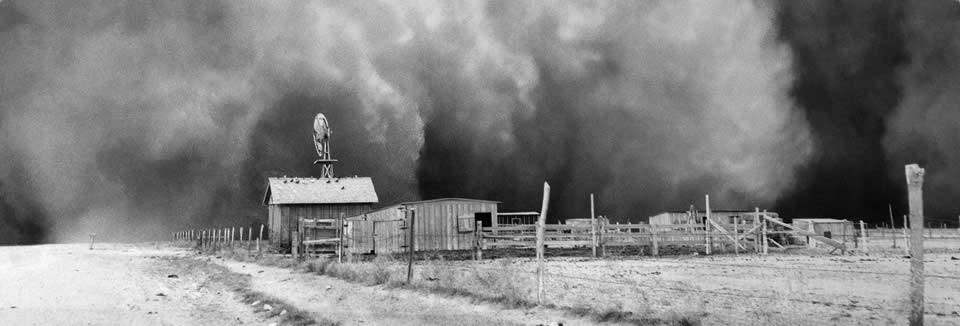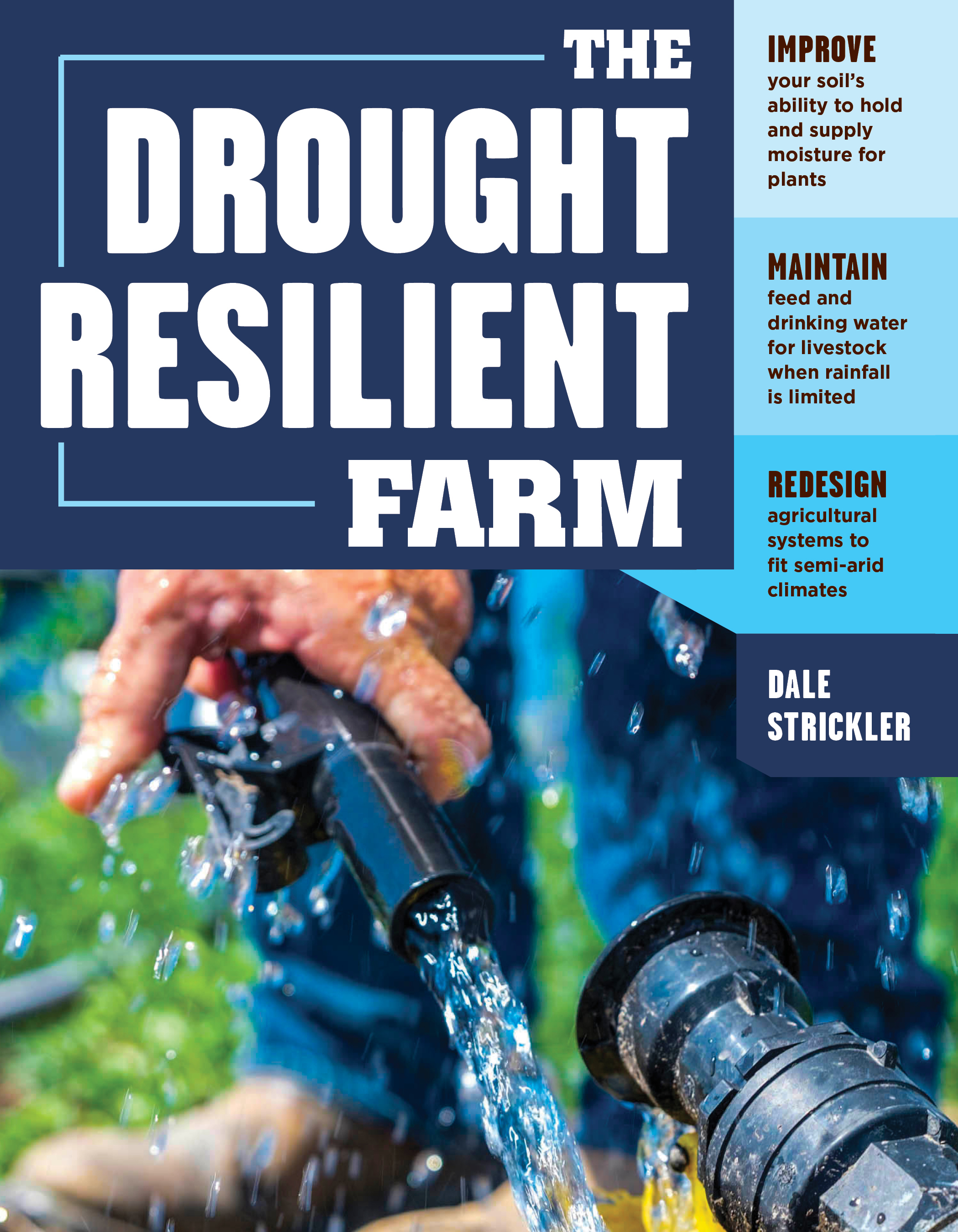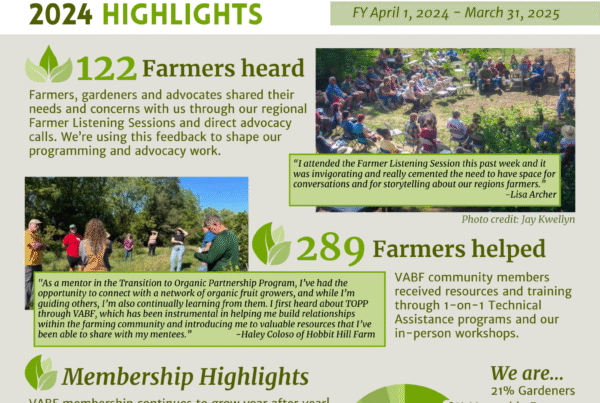Storey Publishing, June 2018.
200 pages, color photos and drawings throughout, $24.95
We all need to read more books like this, to prepare for climate chaos and global heating. Alone, we can’t control how much it rains, or when, but we can improve our farming so that rain penetrates deep into the soil, is stored there and is able to keep plants and livestock alive through dry times. The author farms and ranches cattle in Kansas, using less than 4 acre inches of rain per year. This book is mostly addressed to livestock farmers, not vegetable growers like me. I skimmed some sections, although not much, as the same principles of caring for the soil apply to all farmers. This book is not about Organic Farming. Selective use of herbicides is advocated. But you decide. Selectively graze this book, taking only what you like!
[Oh why are books on sustainable agriculture in the US printed in China?]The first part of the book is about creating a water-efficient soil with three approaches: getting more water into the soil; keeping water in the soil for longer; and helping plants get more of that water. The second part of the book is about providing for livestock: ensuring a reliable water supply; creating drought-tolerant pastures; providing emergency forage in a drought; and livestock decisions after a drought.
Part 3 of this very practical book is Looking to the Future, and includes water-efficient agriculture for semi-arid regions. There are resources for further reading, metric conversion charts and a glossary, and of course an index (without which no practical book is actually practical!) Buy this book to get the checklist of actions to take to prepare for future droughts, and cope with them as they occur.

Ken Burns’ documentary The Dust Bowl should be required viewing, says Dale Strickler. We need to learn from history. Dale learned as a young man that the fantastic corn yields in Iowa were not due to that state having more rain than Kansas, but to the better soils. He also learned it is possible to get better yields on less rain. Poor soils are unable to hold onto the rain they do get. And this is something we can do something about. Dale increased his soil’s ability to hold water from 3†in 18†depth to 12†in the much-improved 6 ft depth after 11 years. Yes it takes time – start yesterday! The three key parts of this feat are:
- Get the water in (not running off)
- Keep it stored in the soil
- Ensure the plant roots can get the water out when they need it.
Getting more water absorbed into the soil depends on creating a good soil structure, with good-sized water-stable aggregates and large-sized pores. Minimizing heavy tillage (think compaction) will help towards this goal, as will increasing the organic matter, using organic mulches, including crop residues (Dale’s excellent example shows the true costs of baling corn stalks for emergency fodder and selling at $60/ton, while incurring costs of $30/ton and losing the fertilizer value of those stalks at $49/ton). After several years of this treatment, yields go down and the soil loses structure. Over-grazing leads to similar results. Bare soils cannot easily absorb water – keep roots in the ground, and preferably some foliage above ground, at all times. Animal manure on the surface also improves water infiltration – the worms and beetles that feed on the manure make burrows that allow water to reach deeper into the soil.
Dale recommends feeding hay in the fields, either unrolled or with bales spaced around the pasture. Uneaten hay and the manure add a lot of organic matter and fertility. Mycorrhizal fungi on plant roots exude glomalin, a stable gluey compound that greatly improves soil structure. The fungi themselves act like root hair extensions, increasing water uptake ability. Earthworms make burrows (air and water conduits) and line them with slime, which helps soil aggregation. Decayed plant root channels also let water deep into the soil. For best results, combine fibrous-rooted cover crops (grasses, buckwheat) with tap-rooted cover crops (brassicas, sweetclovers, sunflowers).

Sunflowers are a deep-rooting cover crop.
Photo Pam Dawling
Terracing, or other ways of working on contour help to reduce runoff and make full use of the water that does arrive. Swales, keyline shaping (contour ridges), retention dams in seasonal waterways, all aim to slow down runoff and give more opportunity for water to soak in.
The next step is to bank the water in the soil for longer. We do not want soils that rapidly evaporate all the water, leaving a brickyard. Peat bogs store lots of water, but this isn’t what we need either. How best to manage the water once it is in the soil? Soils lose water in three ways: it gets sucked up by plants, it evaporates from the soil surface, or it leaches down below the root-zone.
Not every drop of water sucked up by plants is helping us – manage or eliminate weeds to leave more for the crops. Preventing a pound of smartweed growth can save 678 pounds of water! Better to grow a pound of crop plants. Overcrowded plants grow taller, but not stronger, as the roots are restricted. Get weeds early, we all know that. If you’ve forgotten why, this book will remind you of the science! In pasture, many weeds are crops, as far as the livestock is concerned. Sometimes rotating different types of livestock will make best use of the plants you have.
As the amount of CO2 increases, plants become more water-efficient. This is because they don’t open their stomata so wide to get enough CO2, and less water transpires out. Increase the CO2 held in the plant canopy by reducing tillage (which instantly flushes out lots). Organic no-till systems allow natural decay and slow release. Keep lots of organic matter on the surface, and if your soil is acidic, add lime.
To reduce evaporation, provide shelterbelts and windbreaks, which cut the wind speed. Research has shown that woody windbreaks increase yields from an area ten times their height. And yet, when times get hard, some farmers pay good money (that will never come back) bulldozing hedgerows to gain a tiny amount of land, with no understanding of the coming decline in yield. Protecting the soil from excessive sun can also reduce evaporation (minimize bare soil). The book has a convincing photo comparing tall healthy corn planted into hairy vetch mulch, with a shorter, curled leaf droughty corn on bare soil.
Dale explains the Law of the Most Limiting Factor, which is helpful to overwhelmed farmers seeing lots of problems. Tackle the factor that is the first to limit the growth of the crop, whether that is sunlight, nitrogen, water or something else.
Organic matter in the soil improves water-holding capacity (both the depth of water penetration and the amount per inch). Increasing soil organic matter comes up next. Anyone over 50 might have been taught that it is not really possible to increase soil OM at a reasonable price. This is not true! By good soil husbandry you can indeed improve soil OM. Conserve crop residues, add cover crops, add manure or compost, reduce tillage and observe the C:N ratio needed for humus production (1 part N: 10 parts C) and don’t forget the sulfur. Some studies seem to show that feeding the crop residues to livestock, letting the manure stay on the fields can increase yields even though the measurable %OM is not higher than if the residues had been left on the field.
The focus then moves on to helping plants get more of the water out of the soil. Improving root depth is key, but sub-soiling is not usually a good way to do this, although Dale concedes that in the Southeast, it can work for one year at a time, perhaps replacing the heavy frost heaving that happens in winter further north. If possible, find other ways to reduce compaction. The more water there is in the pore space, the less oxygen there is. Field tile drainage can help remove excess water, and prevent a low level of oxygen limiting root growth. Earthworms, deep-rooted plants, increased OM, improved aggregation all help increase oxygen flow to the roots. Increase root water-efficiency by ensuring adequate fertility; enlist mycorrhizal fungi by using an inoculant if needed.
I’m considering photocopying the chapter summary pages for a Cheat Sheet on those Practical Strategies. As I said, I skimmed the livestock farming details, but the information on the impact of drought on livestock farmers and ranchers gave me compassion for those faced with suffering animals. Having to make decisions in a hurry to prevent undue suffering can lead to long term problems for the farm. Sometimes row crops must be sacrificed to provide fodder, when pastures become “crispy brown exercise lotsâ€. Dale has the experience. He tells of neighboring farmers getting together to net all the fish from all their ponds before the ponds dried up. They had a neighborhood fish fry, and he ate fried snapping turtle that day.

There are several reasons to keep livestock out of ponds – one is danger from ice.
Photo Ezra Freeman
Providing surface water includes keeping well-maintained ponds that livestock do not trample down. Dale shows how to provide a livestock “beach†with geotextile and gravel, and old tires forming a fence in the water. He shows how to set up a siphon to bring water out of a pond; how to set a living willow hedge to protect steam banks and pond edges; how to build a shade roof for cattle that catches and provides rainwater; how to build temporary ponds with rubber sheeting and hay bales or earthbags; how to drill a shallow well; and how to enclose a spring to protect it from trampling and provide clean water. Here’s info on addressing water quality issues such as excess nitrates, blue-green algae, salt, and sulfates; and on the use of fish trap gates to encourage livestock to move themselves to the next paddock when they need water.
The next chapter is on creating drought-tolerant pastures. Test the soil, and choose pasture plant species carefully. Here is a good explanation of the three photosynthesis pathways, discovered so far. C3 plants have 3 carbon atoms in the first product of photosynthesis. Cool-season grasses and almost all shrubs, trees and broadleaf plants (think brassicas and legumes) are in this group, which has the poorest water-efficiency, and on hot sunny days can use only about 50% of the available sunlight. The book explains why. While the plants have plenty of water, they can use it to cool the leaves; but if it’s hot and the soil is dry, growth is restricted.
C4 plants include warm-weather grasses (including corn), pigweeds, and lambsquarters. They grow best in hot weather, and are unproductive in cold weather. While they are more water-efficient, they are less digestible and low in protein. It is wise to interseed C3 and C4 grasses, adding appropriate mycorrhizal fungi for the C4 grasses, to speed up establishment and provide better long-term productivity. Add deep-rooting plants (chicory or alfalfa).
The third photosynthetic pathway mentioned is the Crassulacean Acid Metabolism (CAM) pathway, and it has by far the best drought tolerance. This pathway is found in succulents such as yuccas, cacti, pineapples. They close their stomata during the day, having stored CO2 for photosynthesis. These otherwise promising-sounding plants grow very slowly. They may have a place as drought rations, once the spines have been burned off, or the whole plants have been ground to a “soupâ€.
Calculating and maintaining a sustainable stocking rate will prevent the downward spiral that comes from overgrazing. Stock conservatively such that only 40% of the foliage is removed in the worst years. There are no financial savings from overgrazing. Removal of more than 40% of the leaf area results in a loss of root growth, hindering recovery. You make more money from conservative grazing than from exploitative grazing. The book has the research to prove it. Consult your local NRCS, who can calculate a suitable stocking rate (free of charge). In wet winters, it is often better to make a woodchip mulched winter feeding lot with spaced hay bales, than let the soil get “puggedâ€.
There is technical information here about growth stages of different grasses – it’s most important to avoid too much defoliation of cool-season grasses in late spring; warm-season grasses benefit from a rest in late summer. Plants with growing points near the ground can survive close grazing better than those with elevated growing points.

Author Dale Strickler.
Photo courtesy of Storey Publishers
Chapter 7 delves into providing emergency forage in a drought, as an alternative to reducing stocking levels and thus reducing income (hard for any farmer to do). Hopefully, using the previous info, your pastures will be improved and more drought-resilient, and you are less likely to face this emergency. If you do, the first place to look is failed rowcrops, which you can graze or cut and haul (grazing is better). Beware the urge to make silage, as it loses 20% of the feed value in fermentation. And it’s heavy to haul. Also, it leaves your fields denuded, unless you immediately sow a cover crop, which is tricky in a drought. Strip grazing using electric fencing is a better way to go, and also lets you force a better balanced diet of grain and stalks on your livestock, reducing the risks of acidosis, excess nitrates or prussic acid poisoning from young sorghum growth.
Another source of emergency rations is crop residues, such as corn stalks, strip grazed as for failed crops. It is important to understand the nutritional limitations of what you are feeding. There are feed additives used by some ranchers to increase the digestibility of some feedstocks.
Winter cover crops are another emergency feedstock in desperate winters. Tree branches, or felled trees, can save the season occasionally (obviously not every year). Plan ahead and cut poles of cottonwood or willow (whichever grows locally) and plant your own emergency feedlot. It can serve as shade and shelter in non-drought years until needed. Possibly thinning the trees the first time round could actually improve the health of the spared trees.
Another approach is to cut hay on areas that would otherwise get mowed, such as roadsides or parks or serve wetland plants, weeds, lawn clippings, dormant grasses (those bison weren’t wrong!). If you can supplement the protein with legume hay or oilseed meals, do that. For low protein feeds such as dormant grasses, choose mature, non-lactating animals. Planning ahead, it makes sense to shift the birthing season to the beginning of the high-quality grazing season.
There are various (sometimes painful) livestock decisions to make during droughts and in the aftermath. Dale recommends making a written plan, which will save revisiting the decisions each day, and will reduce the stress of making decisions in the thick of it. Deciding to reduce the herd size is easier if you have some animals that you find easier to let go of. Having such “stocker animals†that you intend to sell at some point reduces the decision to when to sell. Having some pre-set trigger dates when decisions need to be made will help you ease into it. Set an initial date to decide the stocking rate for the season, and another when half the growth of the grass will have occurred, for both your cool season and your warm season pastures.
Another strategy is to have some of your livestock be able to survive in buildings or dirt yards for a while. Far from ideal, but in a drought, we are already far from ideal, and climate chaos is going to throw us into situations we have never seen before. Make a priority list of which animals must be first to go when a reduction is needed.
When you’ve done all the things mentioned, and you still have animals to feed, look thoughtfully at hay, silage and grain. It is better to start feeding some hay while the pastures are still in good shape than to overgraze and then have only hay. You want your pasture to respond quickly as soon as rains do arrive, to regrow and be stored for winter. Have a sacrifice lot or pen, where you feed hay, and keep the animals off the pasture, so it can recover sooner. Or graze for a few hours, then feed hay in the lot.
Whatever else you do, keep notes of your observations, your actions, the results and anything you think would have been better. This will position you for better results next time.
The last part of the book looks to the future. The cautionary tale of how the Dust Bowl was created by poor farming practices is relevant to all of us. The lessons are: Farm to suit the land, the climate and the plant species already growing; don’t believe theories (“Rain follows the plowâ€, “Use dust mulchâ€, “Deeply tilled soils will catch more rainâ€) disseminated by people living far away, or companies that are set to gain from farmers following their advice; don’t move hundreds of miles and expect to farm the same way you did “back homeâ€; check the research for results you can depend on, think it through for yourself, and watch what is working for farmers around you, before trying something really different.
Reading about how the Plains are suited to grazing is instructional for anyone who thinks animals should be eliminated from agriculture. Living in central Virginia, I am not in a place to make an informed judgement, but Dale Strickler is. He has a system of capturing falling rain in grasses or cover crops, converting 40% into meat or milk (by grazing, which adds manure to the soil) and leaving 60% to cover the soil. In drought years, maintaining a flexible mind, using those decision-point dates to make best choices for the current year, having some “flex-pasturesâ€, considering all your options rather than panicking, are going to help.
By Pam Dawling







